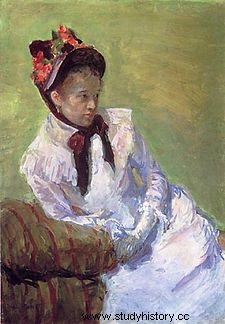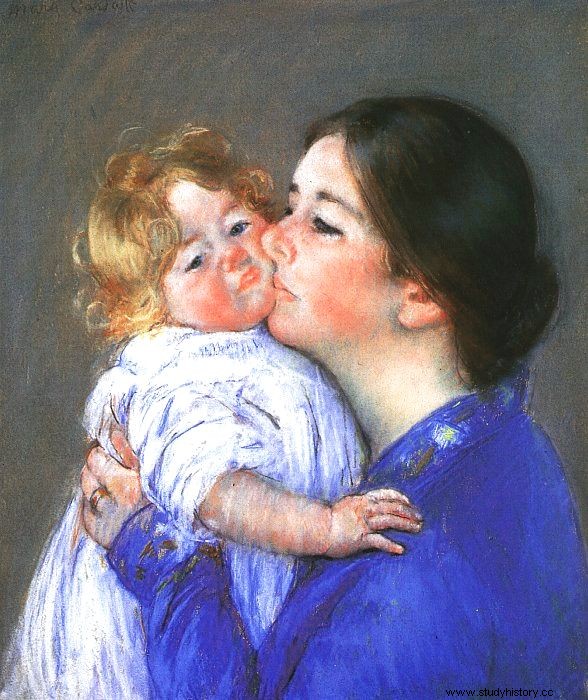Mary Stevenson Cassatt , known as Mary Cassatt, (1844 – 1926), is an American painter, often considered as an impressionist but rather from the generation of post-impressionist painters.
A European childhood
 Born May 22, 1844 in Allegheny Citu (Pennsylvania, United States), Mary Cassatt was the fourth child of Katherine Kelso Johnston and Robert Simpson Cassatt. Her family is descended from French emigrants who arrived in the United States in the 17th century, the Cossarts, and Mary is fluent in French.
Born May 22, 1844 in Allegheny Citu (Pennsylvania, United States), Mary Cassatt was the fourth child of Katherine Kelso Johnston and Robert Simpson Cassatt. Her family is descended from French emigrants who arrived in the United States in the 17th century, the Cossarts, and Mary is fluent in French.
In 1851, when Mary was seven years old, the Cassatts left the United States for France and then Germany, to introduce their children to European education and the European way of life. During this trip, Mary learns French, German, drawing, music. She visits museums and exhibitions and notably discovers Ingres, Delacroix, Courbet. In 1855, her brother Robbie died of bone cancer and the Cassatts returned to Pennsylvania, where Mary resumed her drawing lessons.
Exhibition at the Impressionist Salon
Despite the objections of her family, Mary Cassatt entered the Academy of Fine Arts of Pennsylvania in 1860 but left after two years, disappointed with her training and tired of the paternalistic attitude of teachers and students. In 1866, she returned to live in Paris with her mother and a fellow student, Eliza Haldeman. Since women were not accepted at the Beaux Arts, she studied with a master, Jean-Léon Gérôme, while her mother returned to the United States. In 1868, his painting The Mandolin Player is accepted at the Paris Salon. She perfected her art by traveling to London, Turin, Parma, Antwerp while the Paris Salon continued to accept her works.
In 1875, the Paris Salon refused one of his works. That year, Mary met the painter Edgar Degas and, when in 1877, the Salon refused another of his works, he advised her to exhibit at the Salon des Impressionistes. In 1879, she exhibited there in 1879 her painting Lydia in a dressing room wearing a pearl necklace and immediately feels at ease in the Impressionist environment. She started seeing Degas, Pissaro and Berthe Morisot.
Portraits of mothers and children

In 1882, Mary Cassatt's sister, Lydia, died of illness and Mary embarked on a series of portraits of mothers and children, which became her favorite subject. In 1890, she visited an exhibition on Japanese engraving which strongly marked her and profoundly influenced her art. She then worked on engraving and etchings. In 1892, she painted a mural for the Women's Building of the Chicago World's Fair. In 1904, she received the Legion of Honor.
Deeply affected by the deaths of her father in 1891, her mother in 1895 and her brother Gardner in 1911, Mary sank into depression. In 1914, her vision diminished by diabetes and cataracts, she definitively stopped painting; she became blind in 1921. Mary Cassatt died on June 14, 1926.
